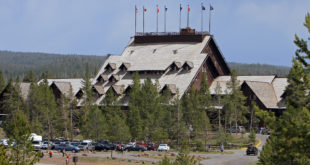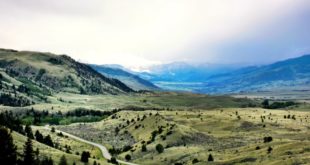
Text by Sean Reichard; illustration by NH King
Anyone who’s been to Yellowstone National Park has seen Old Faithful at least once. It may not be the tallest geyser — Steamboat Geyser is — or even the most impressive — our vote goes to Grand Geyser — but Old Faithful still has its charms and advantages. Though smaller than both Steamboat and Grand, Old Faithful benefits from the fact that it is indeed faithful. Park rangers and officials can predict its eruption time +/- 10 minutes, almost like clockwork. But something is changing with all the predictable geysers in the Park. Over the past ten years, the time between eruptions has increased, whether subtly (Old Faithful went from one hour, 15 minutes to one hour, 31 minutes) or dramatically (Daisy Geyser went from one hour, 40 minutes to two hours, 50 minutes!). In short, something is affecting these geysers — and researchers set out to discover what.
After about two years of research, Shaul Hurwitz of the United States Geological Survey and his colleagues (Steve Ingebritsen and Stuart Rojstaczer) have come up with numerous reasons to explain a geyser’s eruption patterns. Among the most important factors: the weather and climate of Yellowstone National Park.
“We conclude that weather patterns affect geyser eruption intervals,” he said. “Since climate patterns in the Yellowstone area show seasonal and decadal patterns, we expect the ‘environmental’ effects to follow.” A drought would cause eruption intervals to increase, and “in extreme cases make it dormant.”
Another factor is the fracture network creating the plumbing system. “Mathematical simulations published in scientific journals by my colleagues Steve Ingebritsen and Stuart Rojstaczer have showed that small changes in permeability can lead to large changes in geyser periodicity,” Hurwitz said. The Yellowstone region is “susceptible to large earthquakes,” which can change the network of cracks and fissures and lead to completely random results. The seismic waves in an earthquake could cause Old Faithful to cave in on itself, or transform it into a fountain geyser, or even make it erupt every five and a half hours. No one knows what happens until they see it for themselves. For example, in the Kamchatka Peninsula in Russia, a landslide covered up many active geysers. Who could’ve predicted that?
Hurwitz also points out the danger of the thermal systems being used for geothermal developments. While it poses no danger in or near Yellowstone currently, it has affected other thermal systems. At Steamboat Springs in Nevada, “geothermal development has caused cessation of geyser activity.”
So with all these factors that can end or start a geyser’s life in a heartbeat, is there an immediate problem? “No,” he says. An earthquake may be able to alter the inner workings of a geyser, but the last major earthquake happened near Hebgen Lake in 1959. You can’t predict nature, but those are pretty good odds. Also, Yellowstone has high annual precipitation rates, limiting the chance of geysers being wiped out by a drought. The geysers in Yellowstone National Park also have the law on their side, as the National Park Service protects it.
That does not mean, however, that geysers are immune from all these problems. The Yellowstone area is still prone to earthquakes, and precipitation in Yellowstone has been relatively low in the past decade (though Hurwitz is quick to point out that 1997 had the highest precipitation in the last century). But those factors aren’t cause for panic and doubt over the future of Yellowstone National Park’s geysers: “Bottom line — geysers are probably not more vulnerable than before,” Hurwitz says.
So breathe a sigh of relief and know that Old Faithful’s immediate future is not in jeopardy, or that someday soon Norris Geyser Basin will collapse in on itself. Change is all a part of nature and we must be prepared for it. Whether it come tomorrow, next year, or in a 1,000 years, the geysers of Yellowstone National Park (and the world) will not be the same as they are today. The only thing that can be done to preserve geysers is by leaving them alone as much as possible: No littering, no vandalism, and no mucking around with them.
 Yellowstone Insider Your Complete Guide to America's First National Park
Yellowstone Insider Your Complete Guide to America's First National Park





